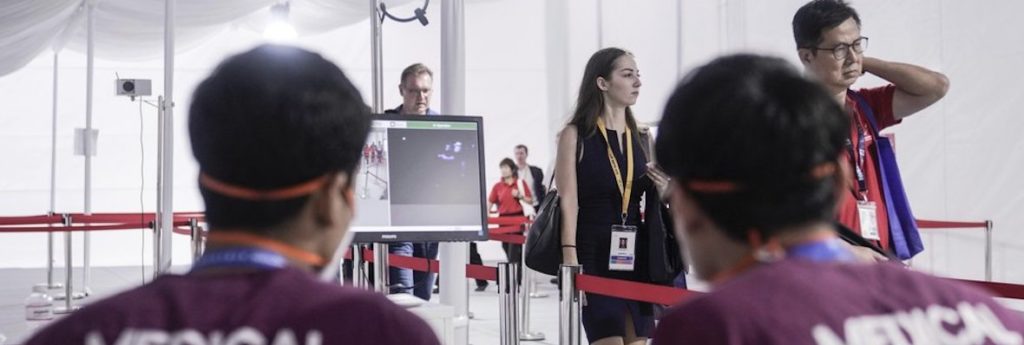Singapore’s air show took off Tuesday with the usual ribbon cutting and displays of aerial prowess, as many industry insiders shrugged off concerns over the virus outbreak that has decimated the regional travel industry. Some visitors heeded warnings from their Singaporean hosts to avoid handshakes and other close contact to keep from spreading the virus that has sickened tens of thousands of people.
But many others just carried on as usual after submitting to multiple temperature checks on their way to the venue, considering it just one risk of doing business.
Singapore has reported 45 cases of the virus, which emerged in central China’s Wuhan. A business meeting at a city hotel last month is thought to have resulted in multiple people from several countries becoming infected. But city authorities opted to go ahead with the air show, taking extra precautions such as limiting the number of visitors, requiring temperature checks and barring entry into Singapore by any foreigners who had visited China in the past two weeks.
“A massive amount of investment and planning goes into these events. Canceling an event of this magnitude would be a major decision,” said Andrew Herdman, director general of the Association of Asia Pacific Airlines.
“You need to make a risk assessment. That’s a challenge we could do without,” Herdman said.
Some 930 companies from more than 100 countries are attending. Still, many booths stood empty and the number of visitors was sharply lower than usual, participants said.
Outside, several big “chalets” of US companies stood empty, with signs on the doors saying they were closed due to concerns over the coronavirus. There were 70 exhibitors that cancelled plans to attend, most after Singapore raised its health alert from yellow to orange last week, include Lockheed Martin and Raytheon Co., Bombadier, De Haviland, Gulfstream and Honeywell Aerospace.
Singapore’s air show is one of dozens held worldwide every year. But it is a highlight for the industry in a vital market and a key marketing and deal making opportunity.
In the outdoor display area, which appeared more than half empty, US Air Force, Navy and Marine staff from as far afield as Hawaii and Oklahoma were standing by their aircraft, but behind barricades after it was decided they would not be giving visitors up-close tours.
Two F-22 Raptors from Joint Base Pearl Harbor-Hickam in Hawaii and two F-35B Lightning IIs are in Singapore for aerial demonstrations at the air show, which is being held at Changi Air Base.
Another highlight of the show, the People’s Liberation Army Air Force’s “Ba Yi” air acrobatics team, put on a dazzling performance in between thundershowers on Tuesday.
Having the Chinese aerial team attend was a reminder of the important role China plays in the industry, even if most of its delegation had to stay away this time, Herdman said.
“China is a very, very big part of aviation globally and the fact that Chinese delegates and Chinese exhibitors are not able to attend is unfortunate,” he said.
Anchored by China’s 1.4 billion people, air travel in the Asia-Pacific region is growing faster than the global average, at 5.4% a year, according to a global market forecast by Airbus.
That is further fueling the long intense competition between market leaders like Airbus and Boeing, but also within the region as China and Japan work to build up their own indigenous aircraft industries.
Airbus used the occasion of the Singapore show to unveil a ray-shaped “blended wing” demonstration aircraft, dubbed MAVERIC, that the European company is developing as part of its effort to explore new, disruptive designs, said Jean-Brice Dumont, executive vice-president of Engineering Airbus.
Boeing joined with Japan Airlines to announce reconfigurations of JAL-owned 787-8 “Dreamliners” for a new low-cost carrier venture launched by JAL called Zipair Tokyo Inc. that aims to provide basic service versions of mid-long-haul flights. JAL said it expects to begin with a Tokyo Narita-Bangkok route in May, followed by another to Seoul, South Korea, in June.

